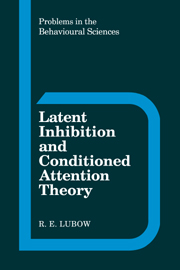Book contents
- Frontmatter
- Contents
- Preface
- 1 Introduction
- 2 Latent inhibition testing procedures
- 3 Variables affecting latent inhibition
- 4 Organismic variables affecting latent inhibition
- 5 Associative learning tests of the effects of stimulus preexposure in children and adults
- 6 Neural substrates of latent inhibition
- 7 Theories and explanations of latent inhibition in animals
- 8 Conditioned attention theory of latent inhibition
- 9 Conditioned attention theory as applied to latent inhibition in humans
- 10 Some applications of conditioned attention theory: learned helplessness and schizophrenia
- Notes
- References
- Author index
- Subject index
3 - Variables affecting latent inhibition
Published online by Cambridge University Press: 13 October 2009
- Frontmatter
- Contents
- Preface
- 1 Introduction
- 2 Latent inhibition testing procedures
- 3 Variables affecting latent inhibition
- 4 Organismic variables affecting latent inhibition
- 5 Associative learning tests of the effects of stimulus preexposure in children and adults
- 6 Neural substrates of latent inhibition
- 7 Theories and explanations of latent inhibition in animals
- 8 Conditioned attention theory of latent inhibition
- 9 Conditioned attention theory as applied to latent inhibition in humans
- 10 Some applications of conditioned attention theory: learned helplessness and schizophrenia
- Notes
- References
- Author index
- Subject index
Summary
Similarity of preexposed stimulus and test stimulus
Studies of the influence of stimulus preexposure on subsequent learning usually assume that these effects are stimulus-specific. That is, preexposure to stimulus A should not retard the subsequent acquisition of an association between stimulus B and another event. This assumption is particularly critical if one maintains the idea that the subsequent decrement in the acquisition of the association between A and another event is a result of some previous associative learning during the preexposure phase. Associative learning, by definition, presumes some degree of stimulus specificity. Indeed, the apparent absence of such specificity in the learned helplessness effect, at least in rats (Maier & Seligman, 1976) in which preexposures of a motivationally significant stimulus is administered, by itself, might raise the question whether or not one is dealing with an associative learning phenomenon. For latent inhibition, across different paradigms, the results are quite clear. The decremental effects of preexposure of the to-be-conditioned stimulus on subsequent acquisition of a new association are, without doubt, stimulus-specific.
Such stimulus specificity may be demonstrated in several ways. (1) A within-subject experimental design may be employed whereby the animal is preexposed to stimulus A and tested on both stimulus A and stimulus B. When appropriately counterbalanced, slower learning to the familiar stimulus compared with the novel stimulus serves as evidence for the stimulus specificity of latent inhibition. Such a design was employed by Lubow and Moore (1959), Reiss and Wagner (1972), and Wickens et al. (1983).
- Type
- Chapter
- Information
- Latent Inhibition and Conditioned Attention Theory , pp. 58 - 95Publisher: Cambridge University PressPrint publication year: 1989



